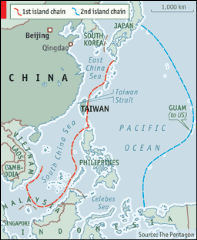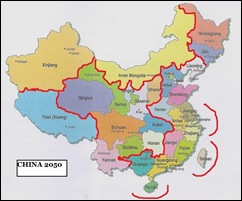One of the pitfalls that many futurists and corporate planners fall into is the trap of thinking in linear terms. In the realms of geopolitical futures, this can be a mistake because it naturally excludes the possibility of change and of big surprises. When we look at works on the future of China, a surprisingly large number of works assume that the current territorial boundaries of China will remain the same into the long term future. A study of the history of China suggests that this may be a false assumption.
When I see a work on the future of China, I always ask how the analysis would differ if the territorial extent of China were to be appreciably larger, and how it would change if it were to be appreciably smaller.
In my own musings, the pressure to expand the territorial extent of China is most likely to come through the re-occupation of the First Island Chain.
 This is an area that encapsulates previous Chinese territorial expansion, and, in the mind of the Chinese government, it represents what is seen as “China”. That the area includes vital sea lanes to China, oil and gas resources, and abundant fish stocks merely brings the area into a sharper focus.
This is an area that encapsulates previous Chinese territorial expansion, and, in the mind of the Chinese government, it represents what is seen as “China”. That the area includes vital sea lanes to China, oil and gas resources, and abundant fish stocks merely brings the area into a sharper focus.
We have also given some thought to what a smaller China might look like. In 2007, as part of the reporting process for our ‘America 2025’ Project, we gave a paper on future geopolitics at the WFS Conference in Minneapolis, USA, where we considered the possibility of a smaller China by 2050. This map encapsulates our thinking at the time:
In our thinking, we speculated that the dissolution of China would start in the west and head eastwards. The two western provinces – Tibet and Xinjiang – don’t really see themselves as part of China. Tibet sees itself as an autonomous nation, which, when I was a boy, it was. Xinjiang has a much closer affinity to Tajikistan, with whom it has a large number of ethnic and cultural links.
As we move through time, the forces of expansion and contraction are both in play simultaneously, and it is through this lens that we can interpret the news. The apparent uprising in Xinjiang suggests that the forces of contraction are evident in western China. However, the recent closer ties with Taiwan also suggest that the forces of expansion are also in play. The balance between the two is likely to dominate our news in the coming years.
156 dead as Muslim uprising hits China - Asia, World - The Independent


No comments:
Post a Comment